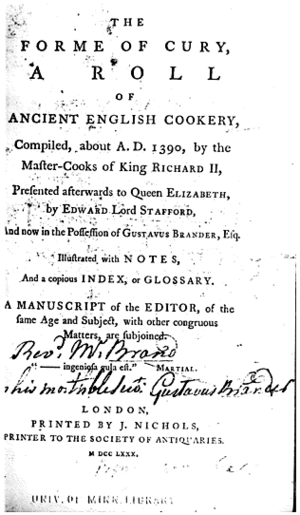Forme of Cury: Difference between revisions
From Cunnan
Jump to navigationJump to search
No edit summary |
m (Reverted edits by 61.47.7.195 (Talk); changed back to last version by Conrad Leviston) |
||
| Line 1: | Line 1: | ||
relelcanocn |
|||
[[Image:Forme_of_Cury_title_page.png|thumb|right|Title page from the Forme of Cury]] |
[[Image:Forme_of_Cury_title_page.png|thumb|right|Title page from the Forme of Cury]] |
||
The '''Forme of Cury''' was the name given by [[Samuel Pegge]] to a roll of [[cookery]] written by the Master Cooks of King [[Richard II of England]]. This name has since come into usage for almost all versions of the original manuscript. It is by far the most well known [[medieval]] guide to cooking. |
The '''Forme of Cury''' was the name given by [[Samuel Pegge]] to a roll of [[cookery]] written by the Master Cooks of King [[Richard II of England]]. This name has since come into usage for almost all versions of the original manuscript. It is by far the most well known [[medieval]] guide to cooking. |
||
Revision as of 09:28, 15 November 2007
The Forme of Cury was the name given by Samuel Pegge to a roll of cookery written by the Master Cooks of King Richard II of England. This name has since come into usage for almost all versions of the original manuscript. It is by far the most well known medieval guide to cooking. The roll was written in late Middle English on vellum and details some 205 recipes (although the exact number of recipes varies slightly between different versions). The following is a sample of a recipe taken from Pegge's 18th Century edition of the roll.
- SAWSE MADAME. XXX.
- Take sawge. persel. ysope. and saueray. quinces. and peeres, garlek and Grapes. and fylle the gees þerwith;. and sowe the hole þat no grece come out. and roost hem wel. and kepe the grece þat fallith þerof. take galytyne and grece and do in a possynet, whan the gees buth rosted ynowh; take an smyte hem on pecys. and þat tat is withinne and do it in a possynet and put þerinne wyne if it be to thyk. do þerto powdour of galyngale. powdour douce and salt and boyle the sawse and dresse þe Gees in disshes and lay þe sowe onoward.
An e-text of the Forme of Cury is available from Project Gutenberg. This version was prepared by the Distributed Proofreaders.
